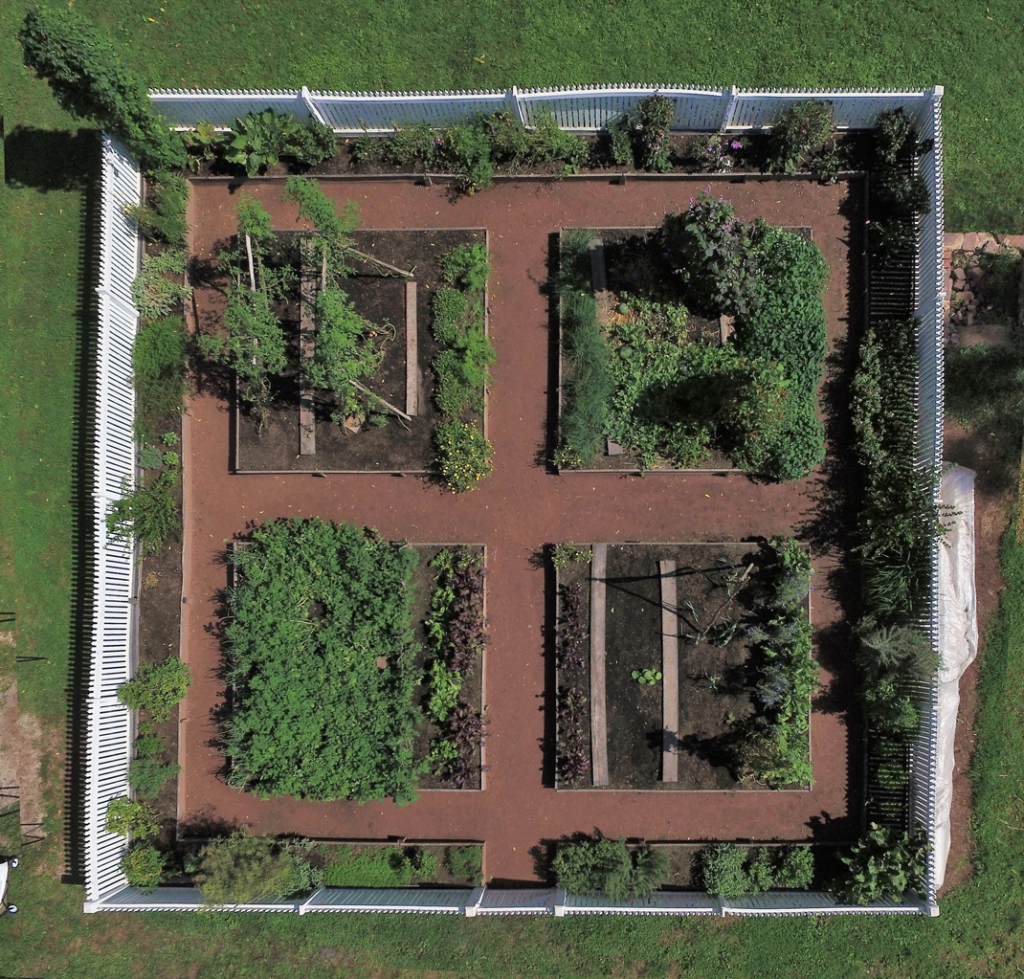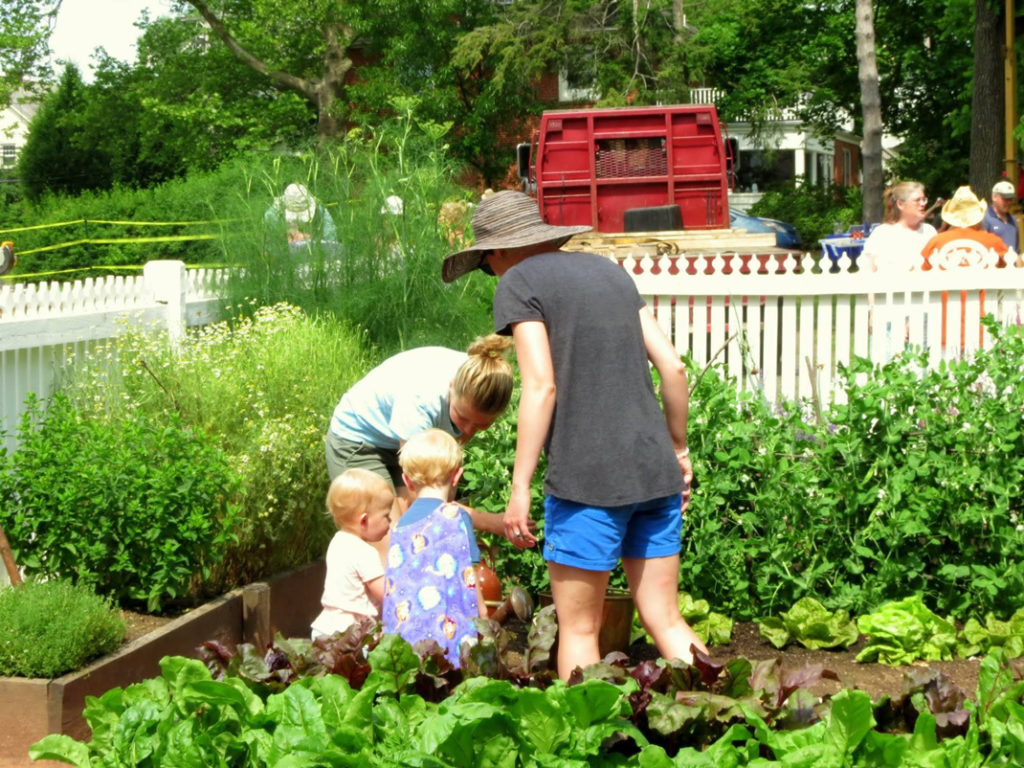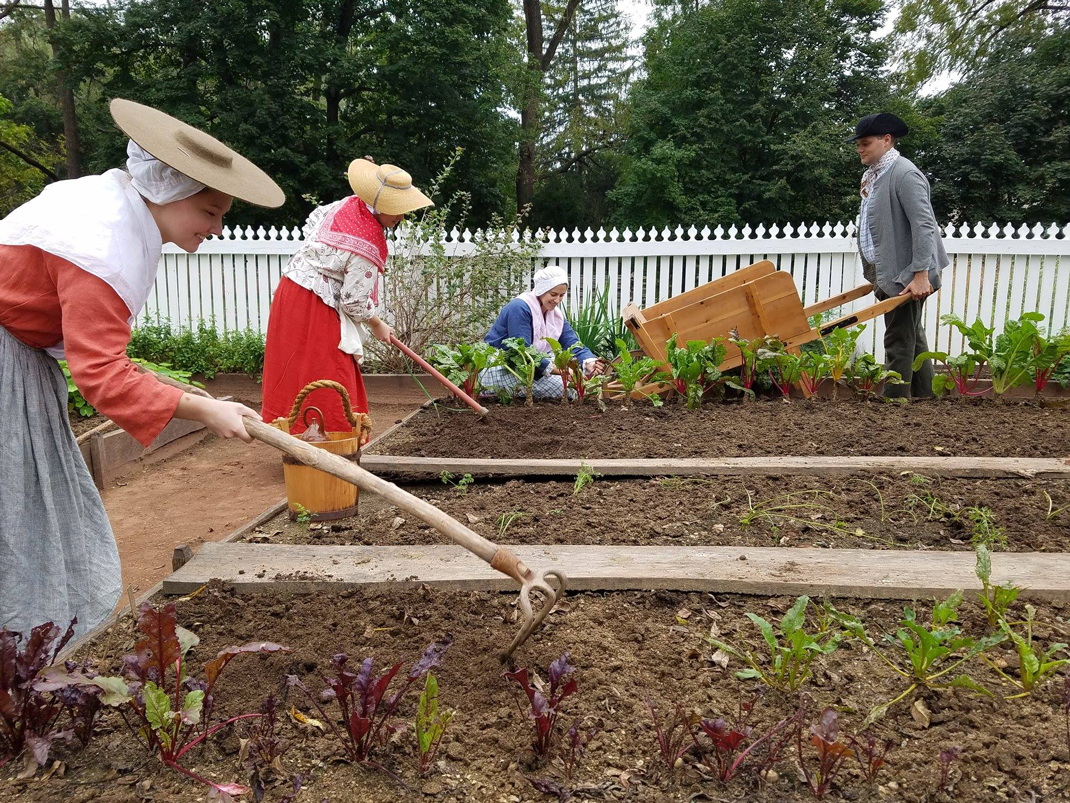Gardens
Historic Trappe has two gardens open to the public: an herb garden at the Henry Muhlenberg House and a kitchen garden at the Speaker’s House.
The Kitchen Garden has a narrow bed along the inside perimeter of the fence is used for growing herbs (closest to the kitchen) and flowers, while the four center beds are used primarily for vegetables. The raised beds provide excellent drainage and enable early spring planting as the soil warms up faster. Historically, raised beds were also used in the winter to store hardy root crops such as turnips, parsnips, and potatoes; a trench was dug and lined with straw, filled with the crops, and then covered with boards and more straw.
Seeds were saved from year-to-year for planting in the garden. Small cloth bags or even specialized wooden chests with numerous small drawers were used to keep the seeds dry and carefully sorted. Seeds were also ordered from professional botanists such as John Bartram (1699–1777), who shipped seeds and plant specimens from his gardens along the west bank of the Schuylkill River near Philadelphia to clients across the United States and in England. In 1802, nurseryman Bernard McMahon (1775–1816) of Philadelphia published one of the first seed catalogue in the United States, which listed 720 varieties of “Garden Grass, Herb, Flower, Tree & Shrub-Seeds, Flower Roots, Etc.” for sale.
The location of our kitchen garden is a best estimate based on archaeological evidence and careful study of 18th- and 19th-century descriptions and illustrations of kitchen gardens. Based on the journals of Frederick Muhlenberg’s father, Henry Melchior Muhlenberg, who lived on the adjacent property to the west, we know that Frederick’s property had a garden as well as some of the plants that were grown in it. Wherever possible, we grow heirloom plant varieties that can be documented to Pennsylvania in or before the early 1800s. Produce from the garden is sold at our farm stand on Saturdays from 9 a.m. to 1 p.m. from mid-May through mid-October.
Funding for the kitchen garden installation was supported in part by a grant from the Pennsylvania Department of Conservation and Natural Resources through the Schuylkill River Heritage Area Grant Program.


Learn more about Pennsylvania German and early American gardens
Beam, C. Richard and Jennifer L. Trout. “Plant Names of the Pennsylvania Germans in PA Dutch—Latin—English,” in Pennsylvania German Treasures (Millersville, Pa.: Center for Pennsylvania German Studies at Millersville University, 2012), pp. 151-268.
Emery, Michael B. and Irwin Richman. Heritage Gardens, Heirloom Seeds: Melded Cultures with a Pennsylvania German Accent (Atglen, Pa.: Schiffer Publishing, 2015).
Greene, Wesley. Vegetable Gardening the Colonial Williamsburg Way: 18th-Century Methods for Today’s Organic Gardeners (Williamsburg, Va.: Colonial Williamsburg Foundation, 2012).
Griffith, Lawrence D. Flowers and Herbs of Early America (Williamsburg, Va.: Colonial Williamsburg Foundation, 2008).
Hatch, Peter J. “A Rich Spot of Earth”: Thomas Jefferson’s Revolutionary Garden at Monticello (New Haven, Conn.: Yale University Press, 2012).
Keyser, Alan. “Gardens and Gardening Among the Pennsylvania Germans.” Pennsylvania Folklife (Spring 1971): pp. 2-15.
Richman, Irwin. Pennsylvania German Farms, Gardens, and Seeds (Atglen, Pa.: Schiffer Publishing, 2006).
Spencer, Darrell. The Gardens of Salem: The Landscape History of a Moravian Town in North Carolina (Winston-Salem, NC: Old Salem Inc., 1997).
Where to see more Pennsylvania German-style kitchen gardens
Historic sites with variations of Pennsylvania German-style kitchen gardens include:
- 1719 Hans Herr House, Willow Street, PA
- Henry Antes House, Frederick, PA
- Burnside Planation, Bethlehem, PA
- Ephrata Cloister, Ephrata, PA
- Landis Valley Village and Farm Museum, Lancaster, PA
- Old Salem Museums and Gardens, Winston-Salem, NC
- Peter Wentz Farmstead, Worcester, PA
- Quiet Valley Living Historical Farm, Stroudsburg, PA
- Renfrew Museum and Park, Waynesboro, PA
- Alexander Schaeffer Farm, Schaefferstown, PA
Where to buy heirloom seeds and plants
Heirloom seeds and plants are available for purchase from numerous vendors, including:
- Baker Creek Heirloom Seeds
- Bartram’s Garden
- Burpee.com/heirloom
- Heritage Harvest Seed
- Landis Valley Museum heirloom seed project
- Landis Valley Museum’s Herb & Garden Fair, held annually on Mother’s Day weekend
- Monticelloshop.org/farm-garden
- Seedsavers.org

